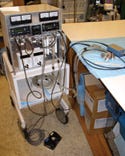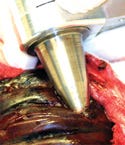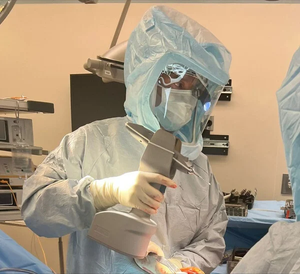November 1, 2007
R&D DIGEST
|
A handheld device seals lung punctures by focusing waves on the wounds. |
By employing high-intensity ultrasound waves, a handheld device could become a fast and minimally invasive way to seal surface lung punctures. The portable device could also help treat patients immediately after an injury, before hemorrhagic shock occurs from excessive blood loss.
Surgeons treat lung trauma by packing the wound, draining out the blood and air, or completely opening the area. However, ultrasound has been shown to seal punctures accurately in one to two minutes.
The device's function is similar to the concept of using a magnifying glass to focus sunlight and burn a specific spot on paper. Instead of light rays, it focuses ultrasound waves that penetrate into soft tissue such as skin or muscles. “If you shine a laser light onto the skin, it can only penetrate about 5 mm maximum,” says Shahram Vaezy, associate professor of bioengineering at the University of Washington (Seattle). “Ultrasound can penetrate 10–20 cm.”
As the ultrasound waves travel deeper into the body, the golf ball–sized device delivers a large dose of thermal and mechanical energy onto a small focal spot about the size of a grain of rice. The heat causes coagulation, which seals the tissue. Researchers conducted experiments on pig lungs to demonstrate the device's effectiveness.
|
Ultrasound has been effective in treating lung wounds because it can penetrate 10-20 cm into the body and seal punctures in a matter of minutes. |
One of the interesting aspects of the technology is that ultrasound can't penetrate tissue such as the lungs because the air pockets scatter and reflect the sound waves back, thereby distorting the ultrasound's focus. However, when the lung's surface has a laceration from a stab wound, for example, bleeding and air leaks occur at the spot. The blood acts as a propagation medium for the ultrasound, says Vaezy.
In addition to treating surface punctures, the device could also be used in bloodless surgery. When removing a tumor, for example, the device would penetrate to a depth of 1.5–2 cm, outlining and isolating the tumor by producing a wall of cautery. The coagulative necrotic wall created around the tumor would limit bleeding as the surgeon uses a scalpel to remove the cancer.
|
Ultrasound waves penetrate soft tissue such as skin and muscles. |
Because the technology can minimize bleeding, the researchers hope it will reduce complications. “We have a study that we hope to publish where we did a lung lobectomy using this device versus the conventional method of staples,” says Vaezy. “In the end, we found that the [ultrasound] device [produces] much less bleeding compared with currently practiced methods.” Vaezy wants to begin clinically testing the technology as soon as possible.
Although this particular device would be applied when the chest is open, the next step for researchers is to use the same ultrasound concept but apply the energy transcutaneously through the skin. Such a technique would require a different device design that features a longer focal length to penetrate through the skin and abdominal layers.
Another potential future use of the device is for image-guided therapy. A surgeon would scan the body and focus the ultrasound beam on any injured areas to seal a wound.
The National Institutes of Health, the Department of Defense, and the National Space Biomedical Research Institute funded the research.
Copyright ©2007 Medical Device & Diagnostic Industry
About the Author(s)
You May Also Like





